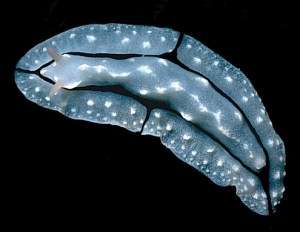
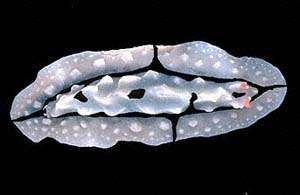
Phyllidiopsis shireenae
Brunckhorst, 1993
Order: NUDIBRANCHIA
Suborder: DORIDINA
Family: Phyllidiidae
DISTRIBUTION
Tropical Indo-West Pacific.
PHOTO
UPPER: 20 m depth, patch reef off Lion Island, southern PNG, 18 June 1988, dorsal view of 48 mm specimen (Brunckhorst, 1993: Plate 8B). PHOTO: D.J.Brunckhorst.
LOWER: Pelorus Island, Nth Queensland, October 1983. PHOTO: Bill Rudman.
Notes compiled from Brunckhorst, 1993:
Phyllidiopsis shireenae is distinctive, on account of its mid-dorsal crest (i.e., the body is not dorsoventrally flattened as in other phyllidiids), very pale pink coloration with a few black lines, and salmon pink rhinophores.
No other phyllidiid possesses a large dorsal crest and salmon pink rhinophores. Phyllidiopsis gemmata is grey-pink to grey-blue with three tuberculate ridges, black rhinophores. Phyllidiopsis krempfi has multicompound pink tubercles, black and pink rhinophores, and possesses 26-28 lamellae on each rhinophoral clavus (17-20 in P. shireenae). Phyllidiopsis pipeki, Phyllidiopsis burni and Phyllidiopsis fissuratus differ from P. shireenae in having large compound tubercles, black and pink rhinophores and pink to grey ventral coloration (white in P. shireenae).
Reference:
• Brunckhorst, D.J. (1993) The systematics and phylogeny of Phyllidiid Nudibranchs (Doridoidea). Records of the Australian Museum, Supplement 16: 1-107.
Rudman, W.B., 1999 (August 1) Phyllidiopsis shireenae Brunckhorst, 1993. [In] Sea Slug Forum. Australian Museum, Sydney. Available from http://www.seaslugforum.net/find/phylshir
Related messages
Phyllidiella rudmani ?- images for your reference
October 1, 2009
From: Sharyn Wragg
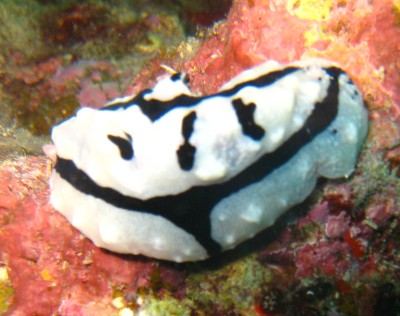
Concerning message #19480:
Hi Bill.
While identifying the phyllids I shot recently on Lady Musgrave Is as P. rudmani, I noted the widely-ranging forms and attach two images in case they are of use in documenting species variability. Rhinophore in one image shows no black tip, but the angle might obscure this - next time I'll know what to look for.
Locality: Lady Musgrave Island, 14m for the, Queensland, 4 July 2009 (Near Lagoon entrance specimen), 8 July 2009 (mooring specimen), Broken staghorn, in current ~ 14m. Length: 5-6 cm. Photographer: Sharyn Wragg.
Cheers,
Sharyn
Sharyn.wragg@anu.edu.au
Wragg, S., 2009 (Oct 1) Phyllidiella rudmani ?- images for your reference. [Message in] Sea Slug Forum. Australian Museum, Sydney. Available from http://www.seaslugforum.net/find/22597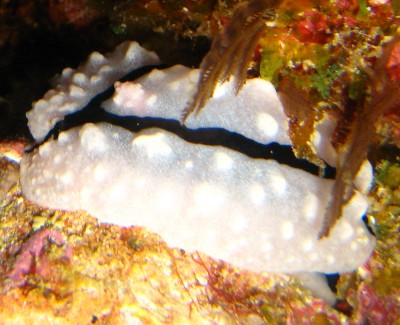
Dear Sharyn,
Thanks for the photos. I'm afraid I can't see the rhinophore you mention. From the general shape and colour of the animals I suspect these are Phyllidiopsis shireenae. Unfortunately, photos of the dorsal surface alone are often not sufficient to identify phyllidiids.
Best wishes,
Bill Rudman
Phyllidiopsis shireenae from Palau
April 1, 2009
From: Marcel Tanke

Concerning message #22318:
Hi Bill,
Here is a bit of an extension to the 'proven' distribution range of Phyllidiopsis shireenae for the Forum; to Palau. It seems to be feeding on the pinkish colored sponge. It has some damage on the middle of the foot.
Locality: Palau, about 10 m, 6 October 2006, muddy. Length: 5 cm. Photographer: Marcel Tanke.
Best regards,
Marcel
marceltanke@cs.com
Tanke, M.A., 2009 (Apr 1) Phyllidiopsis shireenae from Palau. [Message in] Sea Slug Forum. Australian Museum, Sydney. Available from http://www.seaslugforum.net/find/22351Thanks Marcel,
David Brunkhorst, when he described this species, had a specimen from Taiwan, and Scott Johnson has reported it from the Marshall Ids [message #2705] so it would have been strange if it did not occur at Palau, but it is good to get a real record.
Best wishes,
Bill Rudman
Phyllidiopsis shireenae from Mayotte (Indian Ocean)
March 20, 2009
From: Sandrine et Hugues Flodrops
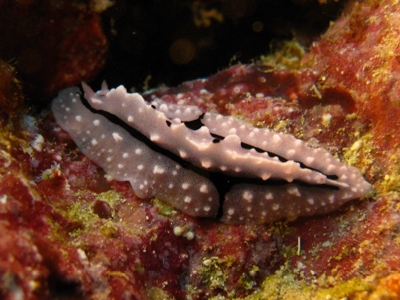
Concerning message #8414:
Dear Bill,
Here is a new piece for puzzle distribution with Mayotte for Phyllidiopsis shireenae
Locality: Boulevard des Platax (Passe en S), 18 metres, Mayotte Island, Indian Ocean, 2 March 2009. Length: 35 mm. Photographer: Hugues Flodrops.
Regards.
Sandrine et Hugues.
hugues.flodrops@wanadoo.fr
Flodrops,H., 2009 (Mar 20) Phyllidiopsis shireenae from Mayotte (Indian Ocean). [Message in] Sea Slug Forum. Australian Museum, Sydney. Available from http://www.seaslugforum.net/find/22318
Dear Sandrine and Hugues,
With the earlier messages of animals from Tanzania, we can definitely say that this species occurs in the western Indian Ocean
Best wishes,
Bill Rudman
Unknown Phyllidiopsis from Indonesia
July 3, 2007
From: Erwin Kodiat
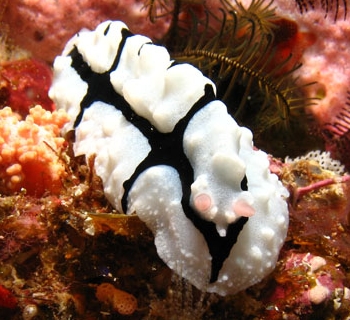
Hi Bill,
Here is another nudibranch from Raja Ampatnch. In my observation, it is quite similar to Phyllidiopsis shireenae, except this one has 2 lateral black lines instead of one. Can you help me ID this?
Locality: Raja Ampat Islands, 20 metres, Indonesia, Pacific Ocean, 23 February 2007, Hard coral. Length: 5 cm. Photographer: Erwin Kodiat.
Thanks
Erwin Kodiat
nudibranch@kapalselam.org
Kodiat, E., 2007 (Jul 3) Unknown Phyllidiopsis from Indonesia. [Message in] Sea Slug Forum. Australian Museum, Sydney. Available from http://www.seaslugforum.net/find/19570Dear Erwin,
The shape of the body, with its high dorsal crest, and the pink rhinophores suggest this is P. shireenae. I think we will just have to add a second transverse black line across the mantle as part of the colour variation of this species.
Best wishes,
Bill Rudman
Phyllidiopis shireenae from east Africa
November 16, 2002
From: Paul Young
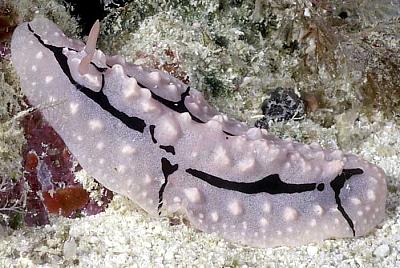
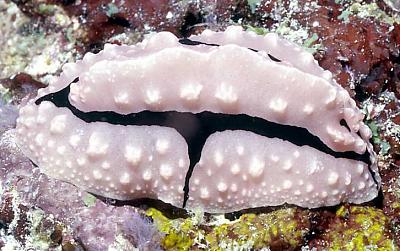
Dear Bill,
Here is one of the nudibranchs that Charlotte and I found at Pemba Island, off the coast of Tanzania, western Indian Ocean, in November/December 2001. The species from the west coast of Pemba are from dives we did with the Fundu Lagoon Resort to small nearby islands.
Both animals were photographed on 27 November, 2001, on the west side of Pemba, but it was also seen on the east side
Best wishes,
Paul Young
young@underwater.org
Young, P., 2002 (Nov 16) Phyllidiopis shireenae from east Africa. [Message in] Sea Slug Forum. Australian Museum, Sydney. Available from http://www.seaslugforum.net/find/8414Dear Paul,
This is Phyllidiopsis shireenae. It joins Bernard Picton's message as one of the few records of this species from the western Indian Ocean
Best wishes,
Bill Rudman
Phyllidiopsis shireenae from east Africa
July 3, 2002
From: Bernard Picton
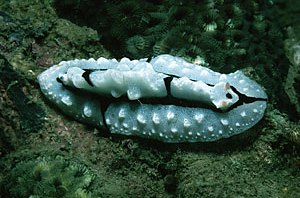
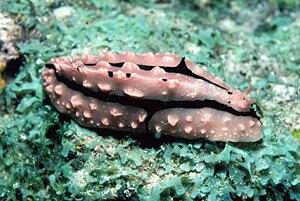
Hi Bill,
Here is a range extensions to East Africa for Phyllidiopsis shireenae. I found it while diving at Pemba Island in Feb 1999. I saw several, large - 60-70mm - animals and they differed from Indonesian ones in being pink rather than white, but the characteristic high ridged body and markings were as normal for this species. I enclose a scan of an Indonesian one from Bali [UPPER] and the Pemba one [LOWER].
Bernard
bernard.picton.um@nics.gov.uk
Picton, B., 2002 (Jul 3) Phyllidiopsis shireenae from east Africa. [Message in] Sea Slug Forum. Australian Museum, Sydney. Available from http://www.seaslugforum.net/find/6468Thanks Bernard,
Certainly extending its known range from one side of the Indian ocean to the other is a significant range extension. It is interesting how many of the greeny-grey phyllidiids seem to range in colour to pink, often in the same population. Perhaps with further observations the grey form will be found in east Africa and the pink on the Pacific side - in fact I just note that the lower photo of mine on the species Fact Sheet from Pelorus Island, Nth Queensland, has quite a pink tinge.
Cheers,
Bill
Phyllidiopis shireenae from Malaysia
June 14, 2002
From: Kheong Sann Chan
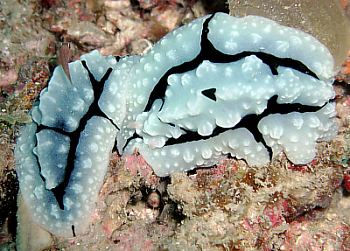
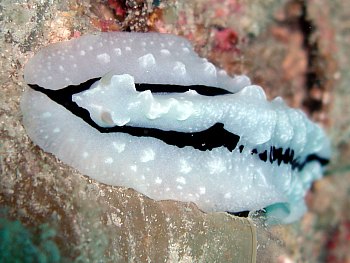
Here are some more photos from Pulau Dayang off the east coast of west Malaysia.
These were around 10cm long.
Location: Dayang, Pinnacles
Date: 8 June, 2002 [8 am]
Depth: 20m
Kheong Sann Chan
kschan@mail.dsi.nus.edu.sg
Chan, K.S., 2002 (Jun 14) Phyllidiopis shireenae from Malaysia. [Message in] Sea Slug Forum. Australian Museum, Sydney. Available from http://www.seaslugforum.net/find/7211Thanks Kheong,
This is Phylliodopsis shireenae. Records on the Forum have greatly increased our knowledge of the distribution of this species.
Best wishes,
Bill Rudman
Another Phyllidiopsis shireenae from Sulawesi
June 10, 2002
From: Lindsay Warren
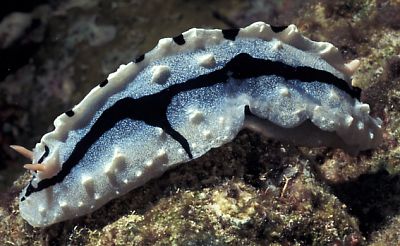
Dear Bill
I was just going through some of my phyllidiid photos and came across a shot of another 100mm specimen of Phyllidiopsis shireenae. This was taken at a depth of 45 ft on Pulau Kaledupa, Tukang Besi Archipelago, SE Sulawesi, Indonesia on 24 August 1998.
Photo: Lindsay Warren
All the best
Lindsay
alldcl@compuserve.com
Warren, L., 2002 (Jun 10) Another Phyllidiopsis shireenae from Sulawesi. [Message in] Sea Slug Forum. Australian Museum, Sydney. Available from http://www.seaslugforum.net/find/7129Thanks Lindsay,
Bill Rudman
Phyllidiopsis shireenae from Sulawesi
May 6, 2002
From: Mary Jane Adams
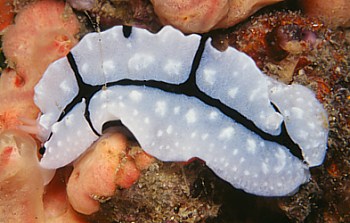
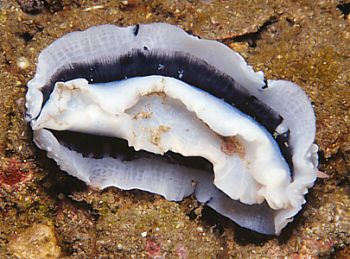
Hi Bill,
Phyllidiopsis shireenae lives in Lembeh Strait too. This one was around 10cm long -- about twice the length of any I have seen in Papua New Guinea or the Solomon Islands. It appeared to be dining on orange sponge. I wanted to see what the gills looked like so I turned it over and photographed the ventral side. Depth: 6metres Divesite: Kepal Indah, Lembeh Island, Sulawesi, Indonesia. April 20, 2002
Best regards,
Mary Jane
divepng@yahoo.com
Adams, M J., 2002 (May 6) Phyllidiopsis shireenae from Sulawesi. [Message in] Sea Slug Forum. Australian Museum, Sydney. Available from http://www.seaslugforum.net/find/6888Thanks Mary Jane,
As records accumulate it looks like this species is widespread in the tropical Western Pacific and at least the east side of the Indian Ocean.
Best wishes,
Bill Rudman
Phyllidiopsis shireenae from Papua New Guinea
October 29, 2001
From: Marli Wakeling
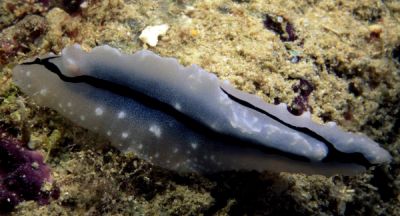
Hi Bill,
I thought the body shape on this nudibranch a bit unusual. I believe it is Phyllidiopsis shireenae.
Dive Site: Dani's Reef, near Kavieng, Papua New Guinea
Date: July 29, 2001
Depth: 20 metres
Length: 100 mm
Photograph: Marli Wakeling
Marli
scubamarli@excite.com
Wakeling, M., 2001 (Oct 29) Phyllidiopsis shireenae from Papua New Guinea. [Message in] Sea Slug Forum. Australian Museum, Sydney. Available from http://www.seaslugforum.net/find/5527Dear Marli,
Yes this is Phyllidiopsis shireenae. For some reason the back half of its body is a bit twisted. I don't know if its from damage or whether its been a bit slow in straightening out after crawling over something crooked.
Best wishes,
Bill Rudman
Phyllidiopsis shireenae from Indonesia
December 28, 2000
From: yasman
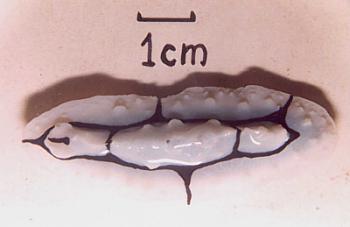
Dear Sir,
Herewith the species of Phyllidiopsis shireenae I found at depth of 75 feet in Karang Lebar Atoll, Thousand Islands, Indonesia. It has white color back ground and pinky rhinophore.
Regards,
Yasman
y.yasman@mailcity.com
Yasman, 2000 (Dec 28) Phyllidiopsis shireenae from Indonesia. [Message in] Sea Slug Forum. Australian Museum, Sydney. Available from http://www.seaslugforum.net/find/3335Thanks Yasman,
You have certainly found quite an extensive variety of phyllidiids at your site in Indonesia.
Best wishes,
Bill Rudman.
Phyllidiopsis shireenae - size information
July 19, 2000
From: Lindsay Warren
Dear Bill
I just looked at the details on P. shireenae and noted the sizes reported. Checking through our records for sightings last year in the Tukang Besi Archipelago, SE Sulawesi, Indonesia (Operation Wallacea) the largest we found was a 100 mm specimen at a depth of 65 ft while the smallest was 30 mm. I don't have the picture to hand of the largest one but will post it to you when I can.
All the best
Lindsay Warren
alldcl@compuserve.com
Warren, L., 2000 (Jul 19) Phyllidiopsis shireenae - size information. [Message in] Sea Slug Forum. Australian Museum, Sydney. Available from http://www.seaslugforum.net/find/2713Thanks Lindsay,
Bill Rudman.
Phyllidiopsis shireenae from the Marshall Islands
July 14, 2000
From: Scott Johnson
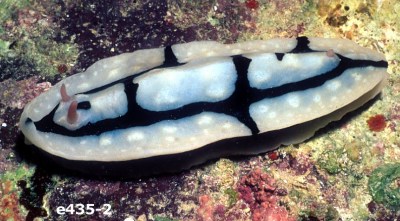
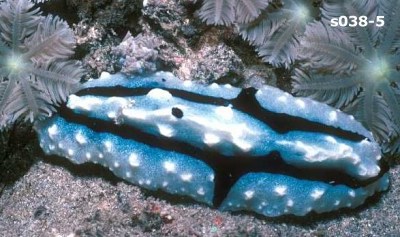
Hi Bill,
I should stop being surprised. I can dive an area for years and years, and still new things pop up. Recently it was Phyllidiopsis shireenae, found by Karen DeGroff on the leeward seaward slope of Kwajalein Atoll at a depth of 35 meters (photo e435-2). I believe this is a considerable range extension. The specimen was a bit moribund by the time I took this photo. At 95mm in length, the Marshall Islands animal is larger than several specimens I saw in the Solomons a few years ago. The other photo (s038-5) is a shot of an individual from Guadalcanal, Solomon Ids.
Scott
johnson@kmr.ll.mit.edu
Johnson, S., 2000 (Jul 14) Phyllidiopsis shireenae from the Marshall Islands. [Message in] Sea Slug Forum. Australian Museum, Sydney. Available from http://www.seaslugforum.net/find/2705Thanks Scott,
I thought this species was known only from the southwest Pacific but as I was posting your message I note that Brunckhorst has a record from Taiwan, and Erwin Koehler recently sent a photo to the Forum from the Maldives. The Marshall Ids record really takes P. shireenae out into the Pacific, so it is clearly a widespread Indo-West Pacific species.
About new things popping up all the time. I remember in Tanzania being quite disappointed when something new didn't pop up every two weeks or so. I guess there are many opportunistic species which only grow to visible size at a particular place if larvae happen to coincide with the presence of their food, which is probably as equally unpredictable.
Cheers,
Bill Rudman.
Phyllidiopsis shireenae from Maldives
December 22, 1999
From: Erwin Koehler
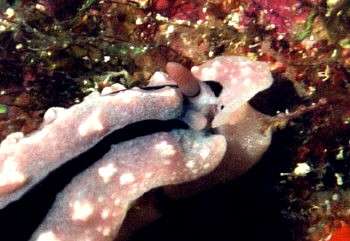
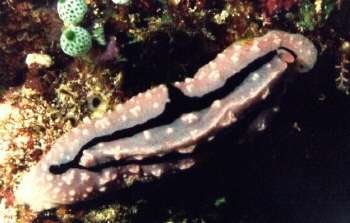
Dear Bill,
Here is Phyllidiopsis shireenae from the Maldive Islands, a very large one with a damaged head.
Gaafaru Island, divesite "Wreck of Lady Christine", Nov. 01, 1999, 74 mm long (!), depth 26 m
Erwin
Medslugs.Koehler@t-online.de
Koehler, E., 1999 (Dec 22) Phyllidiopsis shireenae from Maldives. [Message in] Sea Slug Forum. Australian Museum, Sydney. Available from http://www.seaslugforum.net/find/1699Thanks Erwin,
It seems their nasty chemicals don't give them complete protection from damage - though I guess it apparently lived to tell the tale. Your find is, I think, a new record from Indian Ocean. It is also a new size record as well.
Best wishes,
Bill Rudman.
Phyllidiopsis shireenae from Philippines
January 18, 1999
From: Erwin Koehler
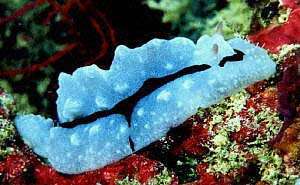
Here is Phyllidiopsis shireenae (Brunckhorst, 1990), from Balicasag Is., Philippines, Nov. 1998
Erwin
E.Koehler@deutschepost.de
Koehler, E., 1999 (Jan 18) Phyllidiopsis shireenae from Philippines. [Message in] Sea Slug Forum. Australian Museum, Sydney. Available from http://www.seaslugforum.net/find/485Phyllidia from Milne Bay, New Guinea
March 3, 1998
From: Wayne Ellis

Hi Bill,
Phyllidia photographed 10 May 1985 at Cathys Corner, Milne Bay, New Guinea, 21m. Day dive.
Regards
Wayne Ellis
glaskin@ozemail.com.au
Ellis, W., 1998 (Mar 3) Phyllidia from Milne Bay, New Guinea. [Message in] Sea Slug Forum. Australian Museum, Sydney. Available from http://www.seaslugforum.net/find/117Wayne,
This is Phyllidiopsis shireenae. The phyllidiids are a family of dorid nudibranchs which have lost their radular teeth, and feed suctorially. Although they are often common we know very little about their biology and on what sponges they feed. They don't have a circlet of gills on their back but have a row of secondary gills along each side of the of the body beneath the mantle skirt. A few years ago David Brunckhorst greatly advanced our knowledge of the family by publishing a monograph reviewing, with colour photos, all the species of the family. I have put details on how to order it in the Book Review section.... Bill Rudman
